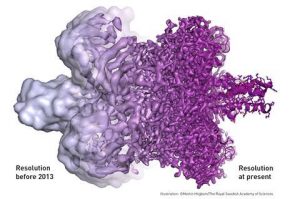Many small molecules are crucial to life—not only are they used for life-saving drugs, but they also regulate important biological processes within our bodies. In order to understand these small molecules better, scientists have developed various methods to probe what atoms they are made up of, and how these atoms are connected.
Yet one of the newest and most promising of these methods is not so new at all—in fact, it has been a mainstream tool in the field of structural biology for years.

The imaging resolution of biological molecules before and after cyro-EM. Source: Martin Högbom/The Royal Swedish Academy of Sciences.
